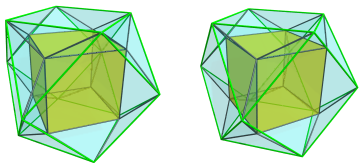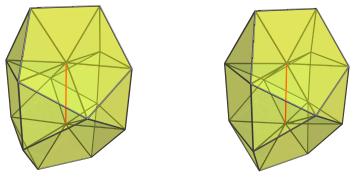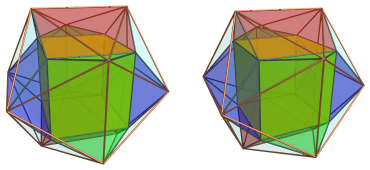4D Euclidean space
News Archive
December 2018
This month, we introduce a CRF polychoron that contains square antiprism cells:
This polytope is known as Cube atop Cuboctahedron
, or
K4.35 among Dr. Klitzing's 4D convex segmentochora. It
consists of a cube, a
cuboctahedron, 6 square
antiprisms, and 8 tetrahedra. It is notable
primarily for being a non-trivial example of a CRF polytope that contains
square antiprisms as cells.
Find out more on the K4.35 page, which also contains its full Cartesian coordinates.
12 Dec 2018:
The Polytope of the Month for December is up.
November 2018
The Polytope of the Month for this month is a curious little CRF polychoron that sports a single bilunabirotunda cell, along with 4 tetrahedra, 4 square pyramids, 4 pentagonal pyramids, and 2 triangular prisms. This is the bilunabirotunda pseudopyramid, or J91 pseudopyramid for short:
Although this polytope is relatively simple in structure, and is probably the simplest 4D polytope that contains a bilunabirotunda cell, it was not discovered until 23 Feb 2014, following the heels of the discovery of the castellated rhombicosidodecahedral prism (also containing J91 cells) and the subsequent discovery that a bilunabirotunda can be derived from an icosahedron via a modified Stott expansion. That latter discovery naturally led to the J91 pseudopyramid as the result of the same modified Stott expansion process applied to the 4D icosahedral pyramid.
Find out more at the J91 pseudopyramid page! As usual, full Cartesian coordinates are included.
16 Nov 2018:
Added the parabiaugmented dodecahedron (J59), yet another Johnson solid.
14 Nov 2018:
The Polytope of the Month for November is finally up! We apologize for the late update.
To make up for the late update, we add another Johnson solid, the augmented dodecahedron (J58).
October 2018
This month, we introduce a simple but highly-interesting CRF polytope:
This is the projection of Cube atop Icosahedron, also known as K4.21, one of Dr. Klitzing's convex segmentochora. It is formed by placing an icosahedron and a cube in two parallel hyperplanes, and connecting them with 6 triangular prisms, 12 square pyramids, and 8 tetrahedra.
It is interesting because its two generating polyhedra come from two different symmetry groups, octahedral symmetry and icosahedral symmetry, unlike most of the other segmentochora where the two generating polyhedra come from the same family. Their common symmetry group is pyritohedral symmetry.
Find out more in the K4.21 page. As customary, we provide the full Cartesian coordinates.
1 Oct 2018:
The Polytope of the Month for October is up!







